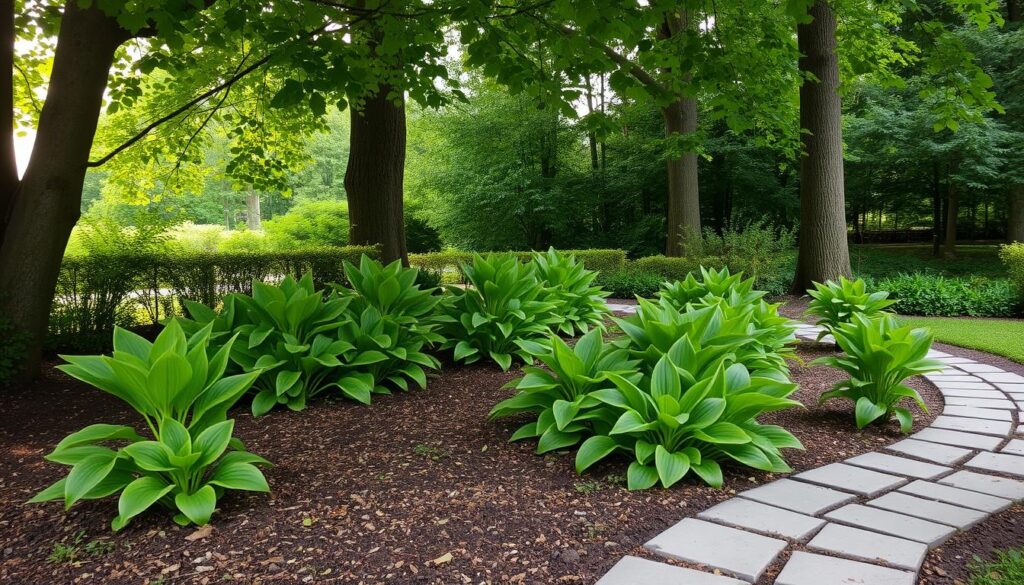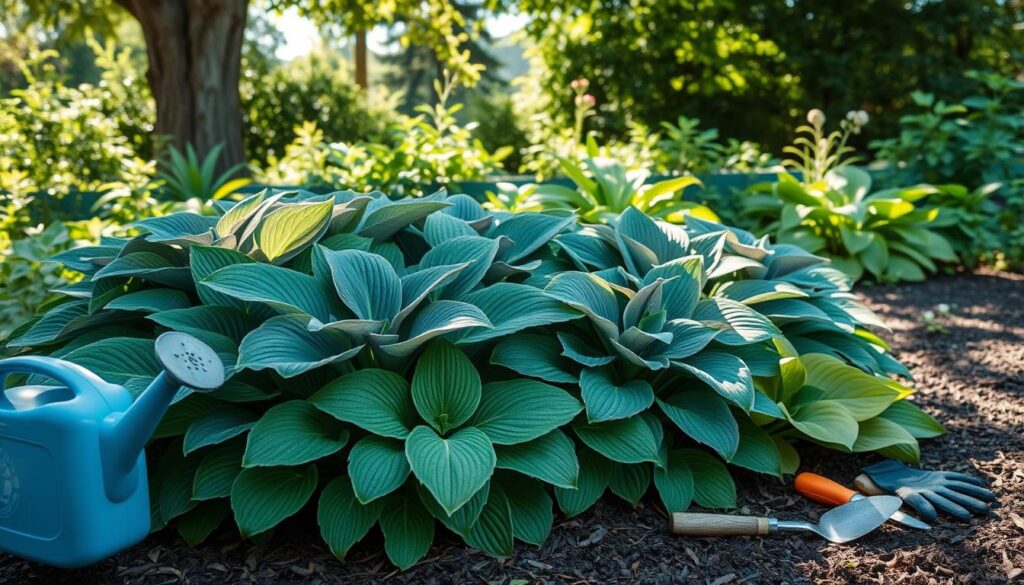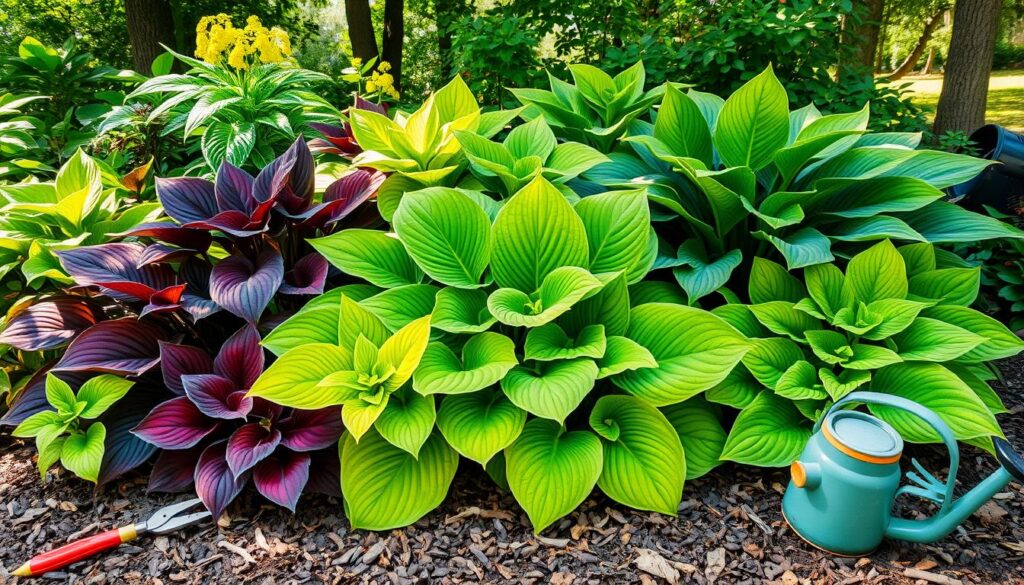Hostas, also known as Shade or Plantain Lilies, are loved for their lush leaves. They do well in shaded areas, making them a top choice for gardens. To keep hostas healthy, it’s key to know the different types and their care needs.
This guide will cover the basics of hosta care. We’ll talk about the best ways to plant and grow them. We’ll also share tips for keeping them healthy all year round. With these tips, you can grow beautiful hostas in your garden.
Table of Contents
Key Takeaways
- Hostas thrive in shaded environments and can grow between 3 and 48 inches tall, depending on the variety.
- It is important to water young hostas 2-3 times per week, ensuring at least an inch of moisture weekly.
- Spacing hostas correctly—15 to 30 inches apart—promotes healthy growth and air circulation.
- Using organic mulch helps retain soil moisture and provides winter protection.
- Hostas are prone to pests like slugs, making vigilant monitoring essential for healthy plants.
Introduction to Hosta Plants
Hostas are loved by gardeners for their beautiful leaves and easy care. They grow best in *part sun* to *full shade*, perfect for shady spots in gardens. Knowing how hostas grow is key, as they come in all sizes. They can be 6 to 48 inches tall and 1 to 8 feet wide.
These plants are not just pretty; they also like different moisture levels. They do best in rich, well-drained soil that stays moist. While they can handle some dryness, too much can harm them. They bloom in summer, showing off purple and white flowers that brighten up the garden.
There are over 3,000 hosta varieties, from small to huge. Some, like Hosta ‘Pandora’s Box’ and Hosta ‘Sum and Substance’, show how different they can be. Whether you want small ones for pots or big ones as garden highlights, they all like shade and moist soil.
Understanding Hosta Varieties
Hosta varieties offer a wide range of choices for gardeners. They can pick plants that match their style and grow well in different conditions. Choosing the right hosta can make gardens look better and ensure each plant gets the best care.
Popular Types of Hostas for Your Garden
Many types of hostas are loved by gardeners. They come in vibrant greens and unique patterns. Some favorites include:
- Abiqua Drinking Gourd: Known for its deep blue-green leaves and unique shape.
- Fragrant Bouquet: Features fragrant flowers and variegated foliage, perfect for adding sensory interest.
- Hudson Bay: A variegated variety known for its resilience and visual appeal.
- Empress Wu: A giant variety showing impressive leaf size and thickness.
To make hostas grow well, it’s important to know their growing conditions. This includes the right amount of sunlight, soil quality, and moisture. These factors are key to keeping hostas healthy and thriving.
Blue-Hued Hostas and Their Characteristics
Blue-hued hostas are known for their striking beauty. They add a unique touch to any garden. Varieties like Blue Cadet and Sieboldiana Elegans are popular for their lush leaves.
They do best in cool, moist conditions. Even though their leaves look delicate, they need little care once they’re settled. Knowing how to care for them, like keeping them moist and shaded, brings out their best features.
Hosta Preferred Growing Conditions
Creating the perfect spot for hostas makes them bloom beautifully. Knowing how they grow helps in caring for them. The right soil and sunlight are key to their health.
Soil Requirements for Healthy Hostas
Hostas love loamy, well-drained soil with organic matter. The soil should be slightly acidic to neutral. Testing the soil every three to five years helps keep it right.
Good soil conditions help hostas grow strong and fight off pests and diseases.
Sunlight and Shade Considerations for Hostas
Hostas do best in shaded spots, but some morning sun is okay. Too much afternoon sun can hurt their leaves. Yellow and gold hostas need 2 to 3 hours of morning sun to stay bright.
Knowing the hosta hardiness zone helps pick the right ones for your area’s sun and temperature.
| Hosta Hardiness Zone | Recommended Sunlight Exposure | Soil Type |
|---|---|---|
| 3-9 | Filtered or Dappled Shade | Loamy, Well-Drained |
| 3-4 | 2-3 Hours Morning Sun | Enriched with Organic Matter |
Where to Plant Hostas
Choosing the right spot is key for hostas to grow well. They love shaded areas or spots with filtered sunlight. Direct sun can burn their leaves, making them weak. So, finding the best place to plant them is the first step.
It’s also important to space them right for good air flow. Hostas should be 15 to 30 inches apart, based on their size. Dwarf varieties need less space, about 9 to 12 inches apart.

Hostas can grow in many soils but prefer a pH of 6.5 to 7.0. Adding organic matter to the soil helps them get the nutrients they need. By following these tips, your garden will flourish and look great.
For more tips on gardening and caring for plants, check out House Gardenia.
Best Time to Plant Hostas
Choosing the right time to plant hostas is key for their health and growth. Knowing the seasonal calendar and weather patterns helps a lot. The best timing is important for hostas to grow well.
Timing and Seasonal Considerations
The best times to plant hostas are early spring or early fall. These times give roots enough time to grow before bad weather hits. In spring, when the soil warms up, hostas grow strong roots as days get longer and warmer.
In fall, planting early helps hostas get ready for winter. This ensures they are strong when it’s cold.
How Weather Affects Planting
Weather is very important for hostas to grow well. Warm, moist weather is best, but extreme temperatures can slow them down. It takes a few weeks for hostas to grow roots before they show above ground.
Adjusting to your local climate and choosing the right conditions is key. This will make your hostas thrive.
| Season | Best Practices | Ideal Conditions |
|---|---|---|
| Spring | Plant early for root establishment | Temperatures above 50°F with moisture |
| Fall | Allow time to acclimatize | Cooling temperatures, avoid frost |
Hosta Maintenance Needs
Knowing how to care for hostas makes your garden look great. These plants are easy to care for and grow well with a little effort. By paying attention to watering and fertilizing, you can help them grow strong and healthy.
Watering Requirements for Hosta Plants
Starting with the right watering is key to hosta care. New hostas need water every two weeks for the first month. After that, they should be watered once a week. In very hot weather, you might need to water them twice a week to keep them from getting stressed.
Fertilization Guidelines for Robust Growth
Fertilizing is important for hostas to grow well. Use a balanced slow-release fertilizer in early spring. You should also fertilize every four weeks until early summer. Don’t fertilize after midsummer, as it can make the plants more vulnerable to pests.

How to Take Care of Hostas Throughout the Seasons
Caring for hostas all year is key to their growth and beauty in your garden. They need special care in spring and autumn. Knowing their seasonal needs will help your plants thrive.
Spring Care Tips for Hostas
When spring comes, get your hostas ready for growth. Remove any old leaves that survived winter. This helps new growth and keeps air moving.
Then, add a 2-3 inch layer of mulch. It keeps soil warm, holds moisture, and stops weeds.
- Water hostas 2 to 3 times a week, ensuring they receive at least 1 inch of water weekly.
- Incorporate organic matter into the soil to enhance nutrient availability.
- Practice good spacing; hostas should be spaced 15 to 30 inches apart based on their size for optimal growth.
Autumn Preparations for Winter Dormancy
In autumn, focus on getting hostas ready for winter. Start by removing debris and cleaning around the plants. This stops pests from hiding in old leaves.
Also, cut back dead leaves before the first frost. This protects the plant and helps it grow better in spring.
- Apply a layer of mulch to insulate roots from freezing temperatures.
- Consider dividing hostas at this time if they have outgrown their space; doing this can produce 4 to 5 new plants, aiding garden expansion.
- Monitor moisture levels and ensure proper watering so hostas remain hydrated before winter.
Pruning and Dividing Hostas
Pruning and dividing hostas are key to growing them well. These steps improve their look and health. Regular pruning helps the plant grow new, strong leaves.
When and How to Prune Hostas
Prune hostas after the frost has gone. This makes the plant grow new leaves. Here’s how to prune right:
- Take off dead or yellow leaves to keep the plant healthy.
- Prune around the crown to improve air flow.
- Use sharp shears to avoid harming the plant.
Dividing Hostas for Better Growth
Dividing hostas is important for their health. Do it every 1-2 years if they get too crowded. The best times are early spring or fall.
When dividing, remember:
- Dig up the whole root ball.
- Split the plant into sections, making sure each has at least three shoots.
- Put the soil back and water well to help it settle.
Smaller parts might take a couple of years to grow. But bigger ones will recover faster. Knowing how hostas grow helps you care for them better.

Dealing with Pests and Diseases
Hostas need care to grow well. They face common pests and diseases affecting hostas. Pests like slugs and diseases like root rot can harm them. Knowing how to handle these issues helps keep hostas healthy.
Common Pests: Identifying and Managing Slugs
Slugs and snails damage hostas, mainly at night. They eat holes in leaves, hurting the plant’s look. To stop them, try:
- Using organic baits to catch and kill slugs
- Keeping the area clean to reduce their hiding spots
- Applying control again after it rains to keep it working
Other pests, like black vine weevil larvae, harm roots and crowns. This can cause leaves to wilt and turn yellow. Watch your plants closely to catch problems early.
Diseases Affecting Hostas and Prevention Methods
Hostas can get sick with:
- Hosta virus X (HVX), showing yellow spots and fast leaf loss.
- Bacterial soft rot, with dead spots and a bad smell, but no cure.
- Fusarium root and crown rot, causing yellow leaves and slow growth. Keeping soil pH right helps prevent it.
To stop diseases, make sure plants get air and don’t get too wet. Check your plants often for signs of sickness. Remove sick plants and soil to stop the disease from spreading.
Winter Care for Hostas
As winter comes, taking care of hostas is key. These plants do well in zones 3 to 9 and need cold temperatures to rest. Good winter care helps them grow strong when spring comes.
Preparing Hostas for Harsh Weather
To get hostas ready for cold, follow these steps:
- Slow down watering as it gets colder.
- Trim dead or wilted leaves after a freeze to keep pests away.
- Water in-ground hostas well if it doesn’t rain in the fall.
- Potted hostas need extra care; water them monthly in winter and keep them safe from freezing.
Mulching Techniques for Winter Protection
Mulching keeps hostas’ roots safe in cold weather. Here are some tips for mulching:
- Use organic stuff like shredded leaves or straw to cover the plant’s base.
- Don’t use untreated terra cotta pots, as they can get wet and crack.
- Keep mulch a few inches thick; too much can hurt the plant or cause rot.
Mulching protects against freezing and keeps soil moist. For more on caring for hostas in winter, check out hosta winter preparation guidelines.
Companion Plants for Hostas
Choosing the right companion plants for hostas can make your garden look better and be more balanced. Hostas do well in shady spots, which is great for gardens with little light. It’s important to pick plants that grow in similar ways and need the same things.
Some good plants to go with hostas are:
- Astilbe – Hardy in zones 4-9, this perennial has beautiful feathery plumes that look good with hostas.
- Bleeding Heart – It grows 2-3 feet tall and is hardy in zones 3-9. This plant adds a sweet touch to shady areas.
- Coral Bells (Heuchera) – It’s about 18 inches tall and thrives in zones 4-9. This plant adds bright colors that make hostas look even better.
- Foamflower (Tiarella) – This low-growing plant grows 8-10 inches tall and loves the same conditions as hostas. It has lovely blooms.
- Brunnera (Siberian Bugloss) – It can grow up to 24 inches tall. Its bright blue flowers look great with the green of hostas.
Choosing the right companion plants for hostas makes your garden look better and helps it thrive. Pick plants of different heights to add depth, like ferns. They can grow tall and contrast nicely with hostas.
By carefully picking these companions, you can create a diverse and beautiful shade garden. Whether you want bright flowers or lush leaves, pairing hostas with the right plants makes your garden healthier.
Containers and Patio Gardening with Hostas
Container gardening with hostas lets gardeners enjoy these plants in small spaces like patios and balconies. It’s important to take care of the soil and plants to keep them healthy.
Best Practices for Container-Grown Hostas
Choosing the right container is key for hostas. Pots should be at least 12 inches deep and wide. This gives the roots enough room to grow.
- Make sure pots have holes for drainage to avoid waterlogging.
- Use a potting mix that drains well, is rich, and slightly acidic to neutral.
- Fertilize in early spring and mid-summer with a balanced 10-10-10 fertilizer.
- Water pots often, more so for smaller ones, to keep the soil moist.
- Watch for wilting, which means the plants need more water.
Refreshing Soil in Planter Boxes
Refreshing the soil in planter boxes is essential for healthy plants. It’s best to replace the old potting mix every 1-2 years. Here’s how to do it:
- Gently remove the hostas from their pots without harming the roots.
- Loosen the old soil and remove any unhealthy parts or signs of root rot.
- Add fresh potting mix, leaving 2-3 inches of space between the plant and the pot walls.
- Include compost to boost nutrient levels in the new soil.
- Water the plants well after replanting to help the soil settle.
By following these tips, container gardening with hostas can be very successful. With the right care, these plants will thrive. They will show off their beautiful foliage and sometimes even bloom. Gardeners can enjoy a lively display in their outdoor spaces.
Conclusion
Learning about hosta plant care is key for gardeners wanting to beautify their landscapes. These perennials need the right growing conditions, seasonal upkeep, and protection against pests and diseases. With the right care, hostas can add a lush charm to shaded spots, making them a favorite among gardeners.
Hostas take a few years to reach their full size, often needing five years for optimal growth. The initial demand for different varieties, like ‘Empress Wu’ and ‘Frances Williams’, has decreased. This means gardeners must focus on proper care, including watering, soil management, and dividing hostas to keep them healthy.
By understanding hosta care, gardeners can create a thriving space for these plants. Enjoying their unique foliage and resilience year after year is rewarding. Hostas not only show a gardener’s dedication but also help maintain the ecological balance in shaded areas, highlighting their importance.
Hostas FAQ: Care & Maintenance Tips
Do hostas require maintenance?
Yes, but they’re pretty low-maintenance! Hostas thrive with minimal effort, as long as they get the right balance of shade, water, and soil nutrients. They do need occasional watering, feeding, and cleanup, but nothing too demanding.
How do you maintain hostas?
Keeping hostas healthy involves regular watering (but not too much), occasional fertilizing, and removing dead or damaged leaves. Mulching around them helps retain moisture and keeps weeds away. If slugs or pests show up, you may need to take action to protect your plants.
What does an overwatered hosta look like?
An overwatered hosta will have yellowing leaves that feel mushy or wilted. The plant may also develop root rot, leading to stunted growth or a foul smell near the base. If you notice these signs, cut back on watering and improve drainage.
Do hostas need to be cut back?
Yes, but only in the fall. Once the leaves turn yellow and die back, cutting them down to the ground helps prevent pests and diseases from overwintering in the plant. In the spring, fresh new growth will emerge.
How do you keep hostas happy?
Give them partial to full shade, well-draining soil, and consistent moisture (but avoid soggy conditions). A layer of mulch helps retain moisture, and a balanced fertilizer in the spring supports healthy growth. Also, keeping an eye out for slugs will help prevent damage.
Do hostas need Epsom salt?
Not necessarily, but it can help! Epsom salt (magnesium sulfate) may improve leaf color and overall health, especially if your soil lacks magnesium. However, hostas don’t require it, so only use it if you notice pale or yellowing leaves due to a deficiency.

